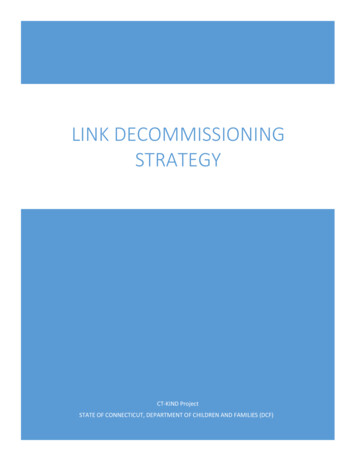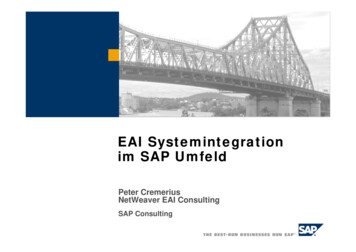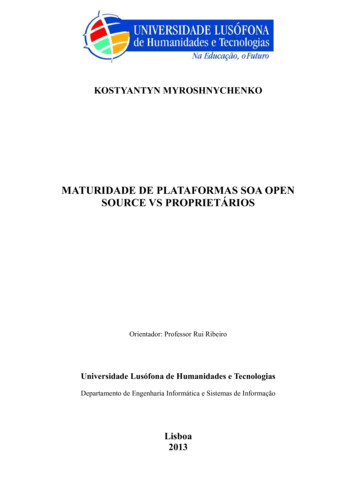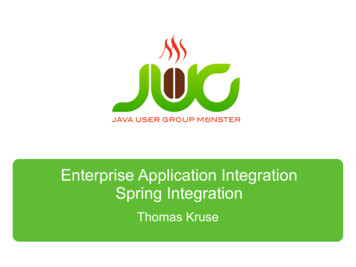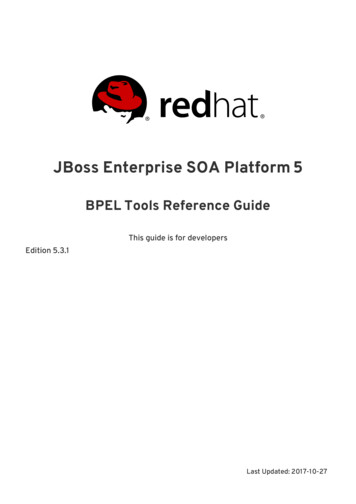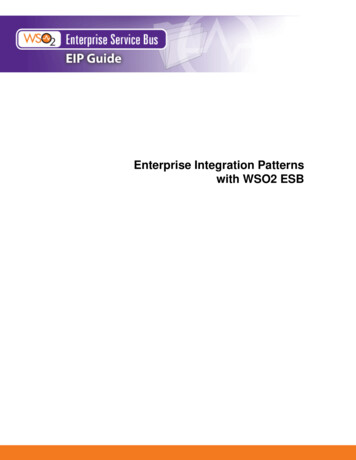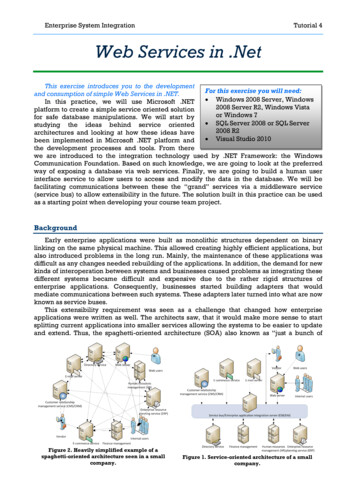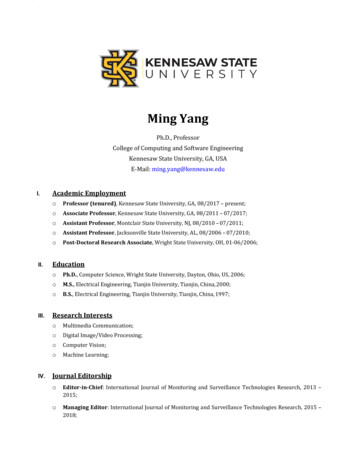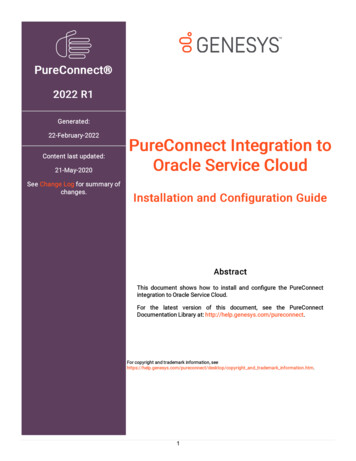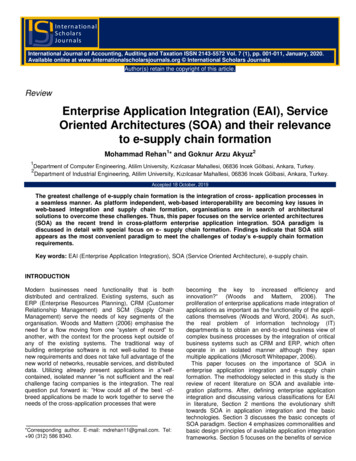
Transcription
In tern a tio n a lSch o la rsJo u rn a lsInternational Journal of Accounting, Auditing and Taxation ISSN 2143-5572 Vol. 7 (1), pp. 001-011, January, 2020.Available online at www.internationalscholarsjournals.org International Scholars JournalsAuthor(s) retain the copyright of this article.ReviewEnterprise Application Integration (EAI), ServiceOriented Architectures (SOA) and their relevanceto e-supply chain formationMohammad Rehan1* and Goknur Arzu Akyuz21Department of Computer Engineering, Atilim University, Kızılcasar Mahallesi, 06836 Incek Gölbasi, Ankara, Turkey.2Department of Industrial Engineering, Atilim University, Kızılcasar Mahallesi, 06836 Incek Gölbasi, Ankara, Turkey.Accepted 18 October, 2019The greatest challenge of e-supply chain formation is the integration of cross- application processes ina seamless manner. As platform independent, web-based interoperability are becoming key issues inweb-based integration and supply chain formation, organisations are in search of architecturalsolutions to overcome these challenges. Thus, this paper focuses on the service oriented architectures(SOA) as the recent trend in cross-platform enterprise application integration. SOA paradigm isdiscussed in detail with special focus on e- supply chain formation. Findings indicate that SOA stillappears as the most convenient paradigm to meet the challenges of today’s e-supply chain formationrequirements.Key words: EAI (Enterprise Application Integration), SOA (Service Oriented Architecture), e-supply chain.INTRODUCTIONModern businesses need functionality that is bothdistributed and centralized. Existing systems, such asERP (Enterprise Resources Planning), CRM (CustomerRelationship Management) and SCM (Supply ChainManagement) serve the needs of key segments of theorganisation. Woods and Mattern (2006) emphasise theneed for a flow moving from one ―system of record‖ toanother, with the context for the process kept outside ofany of the existing systems. The traditional way ofbuilding enterprise software is not well-suited to thesenew requirements and does not take full advantage of thenew world of networks, reusable services, and distributeddata. Utilizing already present applications in a―selfcontained, isolated manner ‖is not sufficient and the realchallenge facing companies is the integration. The realquestion put forward is: ―How could all of the best -ofbreed applications be made to work together to serve theneeds of the cross-application processes that were*Corresponding author. E-mail: mdrehan11@gmail.com. Tel: 90 (312) 586 8340.becoming the key to increased efficiency andinnovation?― (Woods and Mattern, 2006). Theproliferation of enterprise applications made integration ofapplications as important as the functionality of the applications themselves (Woods and Word, 2004). As such,the real problem of information technology (IT)departments is to obtain an end-to-end business view ofcomplex business processes by the integration of criticalbusiness systems such as CRM and ERP, which oftenoperate in an isolated manner although they spanmultiple applications (Microsoft Whitepaper, 2006).This paper focuses on the importance of SOA inenterprise application integration and e-supply chainformation. The methodology selected in this study is thereview of recent literature on SOA and available integration platforms. After, defining enterprise applicationintegration and discussing various classifications for EAIin literature, Section 2 mentions the evolutionary shifttowards SOA in application integration and the basictechnologies. Section 3 discusses the basic concepts ofSOA paradigm. Section 4 emphasizes commonalities andbasic design principles of available application integrationframeworks. Section 5 focuses on the benefits of service
oriented systems. Section 6 discusses their relevance fore-supply chain formation, section 7 provides discussionand Section 8 concludes.ENTERPRISE APPLICATION INTEGRATION: RISE OFSOAEnterprise application integration is defined as ―theprocess of tying together multiple applications to supportthe flow of information across multiple business units andIT systems‖ (Sweat, 1999). EAI is about interoperabilityand information synchronization across multiple applications (mainframe, packaged or purchased systems,and custom application systems), enabling sharing ofinformation, not just within an enterprise or organisationbut within a business environment that includes acompany, its suppliers and its customers. Enterpriseintegration occurs when there is a need in improvinginteractions among people, systems, departments,services, and companies (in terms of material,information or control flows (Vernadat, 2007).The need for developing systems in heterogeneousenvironments to accommodate an endless variety ofhardware, operating systems, middleware, languagesand data stores are clearly mentioned (Bih, 2006);messaging, connectivity and security being as the basicservices needed of an EAI solution (Pan, 1999). Theneed for interoperability is clear for seamless connectivity(Vernadat, 2007) and Legner and Vogel (2008)emphasize that interoperability requires agreements andstandardizations at pragmatic, semantic, syntactic,communication and transport levels.A holistic approach to integration is therefore necessarythat takes into account the business strategy as definedfrom the enterprise vision, the business process definitionand enactment, and the design and operation ofinteroperable enterprise systems as supported by arelevant and efficient IT infrastructure (Vernadat, 2007).As such, handling the business processes and businesslogic are just as important as the data management sideof the issue. Handling the people integration and userinterface issues appears as another critical issue to beperformed independently of the data and processintegration to allow for customized access to sharedbusiness data and logic. Microsoft emphasises that ―anintegrated supply chain requires connecting systems fromthe factory floor to the storefront and across tradingpartners, facilitating business processes that spansystems, and people, within and across organisationalboundaries‖. This further streamlines the criticalbusiness-to-business processes by automating decisionsand providing real-time visibility, covering legacy systemsintegration from different parties as well.Within the context of EAI, literature reveals variousintegration levels. Table 1 provides the basiccharacteristics of these classifications.EAI has been a top issue since 2002, along with the e-businesstransformation,CRM,supplychainmanagement and logistics. The issue is complex since itrequires both internal and external integration of manyincompatible systems (Bolloju and Turban, 2007).Regarding EAI, many different technologies emergedso that a cross-application, integrated view of enterpriseapplications was created, based on the new possibilitiesof the Internet and emerging technology standards suchas HTTP (HyperText Transfer Protocole) and XML(Extensible Markup Language). These new technologiesstarted to bridge the gap among isolated enterpriseapplications and enabled some cross-applicationcoordination and development, however bringing in a newset of problems: ―integration of the integrationtechnologies‖. Many of the solutions are reported to havelimitations or problems including: Being proprietory,platform-dependant or vendor-dependant, requiringsignificant financial and technological resources, beinginflexible (Bolloju and Turban, 2007), assumingsynchronous operations and not scaling up (Vernadat,2007). As such, current solutions are still struggling withovercoming these problems.Woods and Mattern (2006) mention portals, datawarehouses, EAI technology, business processmanagement applications and application servers as thetechnologies for integration. LaFata and Hoffman (2004)also supports these components, mentioning thatEnterprise Application Integration software suites evolvedto handle the complex requirements of application integration, providing the following key areas of functionality:1. An integration broker providing a set of services formessage transformation and intelligent routing.2. Development tools for specifying transformation androuting rules and for building adapters into applications.3. Off-the-shelf adapters for popular enterprise packagedapplications (e.g. SAP R/3).4. Monitoring, administration and security facilities.5. Message Oriented Middleware (MOM).6. Business process managers, e-commerce featuresand portal services.Güner (2005) mentions the following technologies in hercomparative study: Java Message Service (JMS),Remote Method Invocation (RMI), Component ObjectModel (COM), Distributed Object Model (DCOM),Common Object Request Broker Architecture (CORBA),Web Services. Basing on Güner (2005), Akyuz (2008)argues the following:1. In terms of model development, only Web servicesprovide component oriented service development,whereas all others support object oriented approaches.2. In terms of interface definition language, JMS and RMIhave Java dependency and COM/DOM has MicrosoftInterface Definition language dependency. As using WSDL,web services represent the language independency.3. Platform independence is present only for web services
Table 1. Integration levels by various sources.SourceClassificationVernadat (2007)Ibm.com (2007)Woods and Word (2004)SAP NetWeaverBih (2006)Himalayan (2004)Ciol.com (2002)Physical/ application/businessProcess/data integrationPeople/ information/process/application levelsinteraction/application connectivity/process integration/ information integration levelsData/application /process levelsData/method /user interface levelsTable 2. Evolutionary steps towards SOA.Evolutionary stepDescriptionMonolithicLarge scale applications using a procedural coding methodology.Structured or objectorientedDividing applications into units of logic based on functionality. The first step of SOA.Clients and serversThe logical progression of object orientation- bundling groups of functions on the server and invokingthem from client.3-tierAdding an extra layer to interaction.N- tierLayered request-response calls between applications. Portal development relied on this concept.Distributed objectsHeterogeneous system of many distributed objects.ComponentsAggregating objects into logical components that achieve specific functionality and creating interfaces tothese components.Service orientedComponentsAn environment of components interacting in a peer-based environment using interfaces based on widelyaccepted standards to offer services.Source: Based on Nickull (2005).services.4. Interoperability and support for open standards arepresent only for web services.5. Only web services support both synchronous andasynchronous modes of communication.As such, among these technologies, web servicesrepresent highest degree of interoperability, platformindependency and standardisation. Loose coupling, UDDIand WSDL support characteristics of web services alsoput the technology ahead of the others. SOA is a newwave for building agile and interoperable enterprisesystems (Vernadat, 2007) and one of the most organizations (Lior and Seev, 2009).A brief survey on the history of e-commerce andintegration frameworks also reveals a clear shift fromclient/server technology towards integrated and adaptable businesses basing on web services with changingbusiness requirements and technological advances.Güner (2005) mentions this trend by saying ―nowadays,approach to application integration is moving frominformation oriented to service oriented systems‖. Thisevolutionary transition, starting with monolithic structurestowards service oriented components, is also supportedby (Nickull, 2005), mentioning the following evolutionarysteps for the enterprise systems, given in Table 2.The shift towards SOA is also evident in variousintegration platforms developed by proven vendors, likeIBM, Microsoft, Oracle and SAP, who provide clearcommitment to SOA transition in their products (GartnerResearch, 2007). Microsoft BizTalk, IBM WebSphere,SAP NetWeaver and Oracle Fusion MiddleWare integration platforms are among the major ones in this regard,
as also detailed in the study on available applicationintegration frameworks above. Hündling and Weske(2003) and Bolloju and Turban (2007) emphasizes thismassive SOA support of major software vendors andstress the fact that web services technology is the firstmajor technological approach that vendors like IBM,Microsoft and BEA systems join forces on commonstandards. The study mentioned is also a clear evidenceof the rise of SOA in today‘s major propriatory solutions.SOA PARADIGMSOA is an evolution of the component based architecture,interface based design, distributed systems and theInternet in general (Nickull, 2005). SOA refers to thearchitecture for software systems in which services arethe fundamental building blocks, to any system thatexposes its functionality as services (Earl, 2005). SOA isan emerging approach addressing the requirements ofloosely coupled, standards-based, and protocolindependent distributed computing (Papazoglou andHeuvel, 2007). Typically, business operations running inan SOA comprise a number of invocations of thesedifferent components, generally in an event- driven orasynchronous fashion reflecting the underlying businessprocess needs. To build an SOA, a highly distributablecommunications and integration backbone is required.This functionality is provided by the Enterprise ServiceBus (ESB) that is an integration platform utilizing Webservices standards to support a wide variety ofcommunications patterns over multiple transportprotocols and delivering value-added capabilities for SOAapplications (Papazoglou and Heuvel, 2007).The basic idea of SOA paradigm is that a system is designed and implemented using loosely coupled softwareservices with defined interfaces that can be accessedwithout any knowledge of their implementation platform.By overcoming interoperability limitations, SOA allowsexisting software systems to be integrated by exploitingthe pervasive infrastructure of World Wide Web (Canforaet al., 2007). As such, service orientation is a means forintegrating across diverse systems. Each IT resource,weather an application, system, or trading partner, can beaccessed as a service. These capabilities are availablethrough interfaces (Candido et al., 2009). However,complexity arises when service providers differ in theiroperating system or communication protocols, causinginoperability. Service orientation uses standard protocolsand conventional interfaces (usually Web services) tofacilitate access to business logic and information amongdiverse services. SOA allows the underlying servicecapabilities and interfaces to be composed into processes. Each process is itself a service, one that offersup a new, aggregated capability. Because each newprocess is exposed through a standardized interface, theunderlying implementation of the individual serviceproviders is free to change without impacting how theservice is consumed (Microsoft, 2006). As such, serviceorientation is an approach to organizing distributed ITresources into an integrated solution that breaks downinformation silos and maximizes business agility. Theapproach modularizes IT resources, creating looselycoupled business processes that integrate informationacross business systems. Critical to a well-designedservice-oriented architecture is producing businessprocess solutions that are relatively free from theconstraints of the underlying IT infrastructure (Vernadat,2007) to enable the greater agility that businesses areseeking. As such, Service Oriented Architecture (SOA)ultimately enables the generation of new dynamicapplications, sometimes called composite applications(Microsoft, 2006).To enable composite application generation free fromunderlying IT infrastructure, SOA utilizes the concepts ofServices, Web services, Enterprise services, Processorchestration, Process Choreography (Güner, 2005;Vernadat, 2007; Kunti et al., 2007; Candido et al., 2009;Cheng et al., 2010). The basic characteristics of the―services ―concept are being discoverable anddynamically bound, self-contained and modular, locationtransparent, interoperable, loosely coupled, having anetwork-addressable interface, having coarse-grainedinterfaces (Güner, 2005).In SOA, web services describe a specialized type ofsoftware designed to support a standardised way forprovision and consumption of services over the Web,through the compliance with open standards such asXML, SOAP (Simple Object Access Protocole), WSDL(Web Services Description Language) and UDDI(Universal Description, Discovery and Integration)(OASIS, 2005). Web services are designed to supportinteroperable machine- to-machine interaction over anetwork (Güner, 2005). Therefore, Web services are astandard way of creating a self-describing service basedon XML that uses the Internet to communicate, where aservice is a program that talks to other programs.Web Services, unlike traditional client/server systems,are not meant for direct end-user consumption. Rather,Web Services are pieces of business logic, havingprogrammatic interfaces and through these interfaces;developers can create new application systems (OASIS,2005). The motivation behind Web Services is to facilitatebusinesses to interact and integrate with otherbusinesses and clients, without having to go through integration design and/or to expose its confidential internalapplication details. This is made possible by ―relying onthe non-platform dependent and non-programminglanguage dependent XML‖ to describe the data to beexchanged between businesses or between the businessand its clients, using a WSDL to specify what the serviceis providing; using a UDDI to publish and locate who isproviding the service; and typically using SOAP overHTTP to transfer the message across the internet (OASIS,2005; Candido et al., 2009).Akyuz (2008) discusses the clear distinction between
Web services and enterprise services, emphasizing thatenterprise services are new service definitionsdeveloped, typically a series of Web services combinedwith business logic that can be accessed and usedrepeatedly to support a particular business process. Inthis context, a web service is just a standardized interfaceto a service's functionality whereas an enterprise serviceis a web service designed as a reusable component inprocess automation. It exists within the larger context ofESA (enterprise services architecture), and it containsmetadata about its functionality and about how itconnects to other services. Enterprise services are largeenough that combining and recombining them is a fairlyeasy task. An enterprise service, when called, willexecute any number of instructions across any number ofunderlying applications whereas a web service will callonly the application to which it is related (Woods andMattern, 2006). An enterprise service is composed of theservice interface and service implementation. Enterpriseservices are gateways to functionality provided by anexisting system, called a service provider.Aggregating Web services into business-levelenterprise services provides a more meaningfulfoundation for the task of automating enterprise-scalebusiness scenarios (sap.com). Descriptions of enterpriseservices are stored in the Enterprise Services Repository,which contains not only WSDL files but also models thatshow how an enterprise service is related to businessprocesses and business objects. As such, ESA can bedefined as ―the sum of SOA (Service-orientedarchitectures) and ES (Enterprise services)‖ (Feurer,2007). Combined use of SOA and ES allows developinga reusable library of services having service definitions.As such, combined use of BPM (Business ge) and Web Services enables the formation of aservice-oriented enterprise, as given in Figure 1.In this structure, not all enterprise applications are ableto expose the same amount of functionality with the samelevel of ease. Enterprise services resting on top businessobjects, an organized container of functionality and datadesigned specifically to operate well within an ESAframework are able to offer a greater variety of serviceoperations more easily than functionality from anenterprise application that was never designed to provideservices (Earl, 2005).Therefore, enterprise services residing within ESA areloosely coupled, and the composition is not hard codedbut rather assembled through process orchestration andmodelling. They are just combinations and recombinationof underlying services. Therefore, reconfiguring theunderlying scenarios, business processes, and processsteps become the real issue (Earl, 2005). As such, theycan be thought of as standardized Lego pieces to createcomposite application. These components are kept in theenterprise services repository to allow for reusability. Assuch, composite applications are essentially applicationsbuilt out of services provided by other applications. Theyare constructed using web services as building blocks(Woods and Word, 2004) and created through modellingrather than through a programming language.ASTUDYONAVAILABLEINTEGRATION FRAMEWORKSAPPLICATIONWith the critical concepts of SOA and web servicesalready mentioned, an architectural study of variousintegration platforms from proven vendors is performed.The study focused on the following as representatives oftoday‘s major proprietary integration solutions:1. Microsoft BizTalk2. IBM WebSphere3. SAP NetWeaver4. Oracle Fusion MiddleWare SOA suiteBased on Chappell (2005), Simmons (2005), Woods andMattern (2006) and oracle.com, various characteristics,layered architectures, schematic high- level diagrams andmain components (together with the functionalities andinteractions among them) are analyzed for theseplatforms, details of which can be obtained from Akyuz(2008). For the sake of conciseness and clarity, thesediagrams are not included in this paper. Basing on thestudy, it can be argued that these structures revealconsistent results and major commonalities. Althoughthere are slight changes in the naming andresponsibilities of system components, commonalitiesobserved are striking and the following are worthmentioning:1. Master data management (MDM): MDM componentsof the integration platforms provide back-end databaseintegration at both the sender and receiver sides,providing the ability to integrate with ERP backbones.2. SOA: All of the integration platforms clearly exhibit aservice oriented structure, using web services as theenabler of web-based communication. Ability to usestandard web services and creating compositeapplications from available enterprise services aredefinitely presented via development tools supportingcomposite application generation. Therefore, it can easilybe argued that SOA plays a crucial role in thearchitectures of most commonly used integrationplatforms of today.3. Layered structures: All of the integration platformsmentioned exhibit layered structures. For managingcomplexity and assignment of functionalities, use ofconceptual layers appear as a common principle. Onecomponent of an integration platform may be acting inmore than one layer, such as SAP XI, entering into action
Figure 1. Relationship between ESA and SOA. Source: Woodsand Mattern (2006).for both orchestration and service definitions. Similarly,creation of reusable services involves the use of morethan one component and interaction of differentcomponents at different layers.4. BPM: All of the mentioned platforms includecomponents for business process management. Thisrequires providing the definition of business processlogic, having a business process rules engine, relatingthe business rules to the process logic and relating themessages to the business logic. Easy-to-use, graphicaltools and user interfaces for defining and maintainingbusiness logic are also provided. Inclusion of businessprocess management capabilities clearly serves the needfor convergence of SOA and BPM. Defining andsynchronising way of doing business with thetechnological architecture is provided by incorporatingBPM into the integration architecture. This is vital for thesuccess of any implementation, which is evident from thebest practice guidelines and discussion of challengesinvolved in ERP, e-procurement and e-supply chainimplementations. As such, any integration platformshould be able to handle business process definitionsand alignment of business processes with the technology,involving reengineering if necessary. Together with thisalignment, this principle ensures the separation betweenprocess control and process logic.5. Business Intelligence (BI): Consolidating datacoming from various sources into reports that allow forintelligent managerial decisions is vital for businesssuccess and this need is taken care of in all of thesearchitectures. Activity monitoring, alerting, on-lineanalytical processing (OLAP), data warehousing and drilldown reporting mechanisms are definitely commoncharacteristics.6. Portals as user interface: Provides the customizationof interfaces and separation of user interface frombusiness data and logic. This enables modifying the userinterface while keeping the business data and logic intact,making the portal and back-end integrations independentof the sender and receiver platforms respectively.7. Separation of concerns: Refers to the ability toidentify, encapsulate, and manipulate parts of softwarerelevant to a particular concern (concept, goal, purpose).Concerns are the primary motivation for organizing anddecomposing software into manageable and comprehensible parts, which reduce software complexity, improvecomprehensibility; promote traceability; facilitate reuse,non-invasive adaptation, customization, and evolution;and simplify component integration. Facilitates reuse andevolution of system components or systems as a whole(IBM Research, 2007).8. Separation of business data and logic: Enablesmodifying the business rules and logic without changingbusiness data.9. Scalability: The fundamental infrastructure should bedesigned to scale up in order to support current messagevolume and future growth.10. Extensibility: A good integration solution must becustomizable and extensible. A company should be ableto add to and change business processes withoutaffecting the underlying applications, and IT should beable to change applications without affecting businessprocesses.11. Redundancy: Needed to support fault-tolerantconfigurations in order to be used as part of the mission-
critical application solution.12. Single sign-on: Vital design principle needed forproper authorization and authentication.All these findings are definitely compatible and supportedby LaFata and Hoffman (2004) in terms of key featuresand functionalities of EAI software suites.These commonalities are also compatible with Legnerand Vogel (2008), emphasizing that service-basedinteroperability requires agreements and standardizationsat pragmatic, semantic, syntactic and communication/transport levels. Legner and Vogel (2008) clearly indicatethat SOA concepts cover only the lower two layers(transport/communication and syntax) leaving the othertwo layers (pragmatic and semantic) as domain specificand to be addressed by vertical integration. This clearlyexplains the the need and importance of master datamanagement and business process management intoday‘s EAI platforms.BENEFITS OF SOALiterature provides very strong support for the benefits ofSOA from various aspects for information systemsdevelopment and integration.Woods and Mattern (2006) mention the following in thisregard:1. Greater flexibility.2. Promoted modularity.3. Better managing of the complexity.4. Expanded reuse of existing functionality.5. Improved communication between IT and business.6. Simplified and accelerated development and fastertime to market through improved developer productivitybased on model-driven development, removing ITbottlenecks.7. Easier adaptation through modeling and role-basedtools.8. Clearly defined roles from the business analysts to thedevelopers.9. Better encapsulation to allow heterogeneity oroutsourcing.10. Lower TCO (total cost of ownership).11. A foundation for an ecosystem, which enables thedevelopment of an ecosystem of interacting enterprises.12. A foundation for harvesting value from standards.Earl (2005) clearly emphasises that by being based onopen standards, SOA promotes intrinsic interoperability,federation, architectural composability and reusability.These benefits are definitely in line with ESA principlesmentioned by Woods and Mattern (2006) and the keyaspects of loose coupling, autonomy, abstraction,reusability, interoperability and composability mentionedby Candido et al. (2009).Microsoft Whitepaper (2006) argues that by the use ofSOA, simplification of management of distributedresources across multiple platforms, reduced hardwarerequirements, increased reliability and reduced costs arereported, adding upto a dramatic increase in agility andproductivity.Lim and Wen (2003) mention that ―web servicesaccomplish better data integration and unlock businessinformation from the inside of information silos‖. Bollojuand Turban (2007) also emphasizes that for the munication because of vendor, platform andlanguage independence and flexibility due to loosecoupling.Canfora et al. (2007) consider SOA as a ―new chanceto continue using and reusing the business functionsprovided by legacy systems‖. As such, they mention SOAand web services as ―a means of modernizing softwaresystems‖, emphasizing them as ―valuable options forextending the lifetime of mission-critical legacy systems‖.Exposing legacy systems as services allowsheterogeneous systems to become interconne
This functionality is provided by the Enterprise Service Bus (ESB) that is an integration platform utilizing Web services standards to support a wide variety of communications patterns over multiple transport protocols and delivering value-added capabilities for SOA applications (Papazoglou and Heuvel, 2007).
